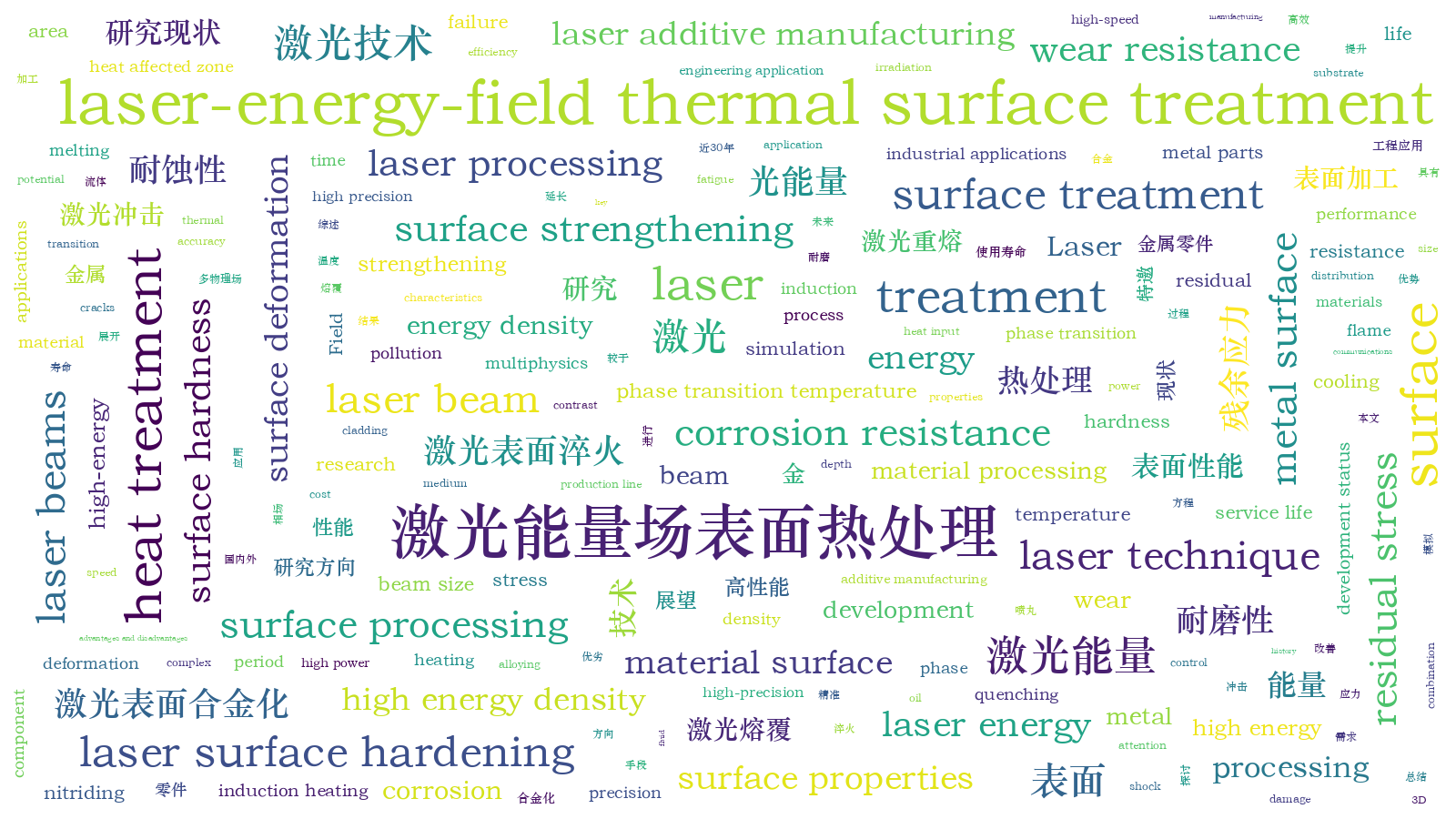高性能金属激光能量场表面热处理技术研究现状及展望(特邀)  下载: 510次特邀综述
下载: 510次特邀综述
Metal part wear and corrosion are predominant forms of damage in engineering applications, prevalent in various fields of national life. Wear and corrosion initially occur on the surface of the part and further extend into the part. Fatigue, cracks, and other forms of component failure also stem from the component surface. Therefore, strengthening treatment for the surface of parts is gaining increasing attention. In material processing, most laser energy can be converted into thermal energy over a short time period. Laser processing involves a high-energy density laser beam which interacts with a metal surface, causing it to melt, gasify, change phases, and solidify. Laser surface treatment is a non-contact process in which the laser beam interacts with the material surface during processing, making it straightforward to control. Laser has the characteristics of high power and high precision, so that laser processing materials have been widely used in engineering, military, industry, communications and other almost all fields.
Surface heat treatment technology has a long development history. For example, surface heat treatment methods such as induction and flame quenching, and carburizing and nitriding processes effectively improve surface hardness, corrosion and wear resistance, and surface fatigue performance. Laser surface heat treatment achieves some advantages over traditional heat treatments. First, accuracy is the most prominent feature. In laser surface heat treatment for parts with complex 3D shapes and structures, controlling the laser beam size significantly reduces the heat affected zone, accurately controls treated and untreated areas, and minimizes heat treatment deformation and residual stress. Using traditional heat treatment methods, parts are heated to the required temperature and subsequently quenched in oil or water for high-speed cooling to achieve the required surface hardness. For heat treatment of thin-walled and high-precision parts, uncontrollable heat input such as overheating or melting leads to a large heat affected zone, surface deformation and uneven hardness distribution on the part surface. In most industrial applications, failure behaviors such as wear and corrosion only occur in specific part areas. Therefore, strengthening areas prone to failure to enhance the performance of parts and extend their service life. Hence, the advantages of using laser surface processing are prominent owing to its highly oriented nature and ability to deliver controllable energy to the desired area.
Second, laser beams have high energy density. For example, in the laser beam irradiation area, a significant amount of heat accumulates over an extremely short time period to reach the phase transition temperature in the area to be processed. Owing to the fact that laser processing only involves local areas, when the laser is inactive, heat quickly diffuses towards the substrate, causing the heating zone to cool rapidly. Therefore, compared to traditional heat treatment methods, an additional cooling medium is not required.
In terms of sustainable development, laser beam heat sources are clean, green, and pollution-free. Compared to nitriding and carburizing heat treatment processes, laser surface heat treatment does not involve chemical reactions during metal melting and pool cooling, and completely avoids chemical pollution. In the mass processing production line, the laser beam improves both laser utilization and higher heat treatment efficiency through the photosystem and the workbench, thus, reducing its cost in contrast to traditional heat treatments.
Traditional metal surface strengthening treatment methods include flame quenching, induction heating surface heat treatment, and nitriding and carburizing chemical heat treatment. Since the 1970s and 1980s, owing to laser development, laser surface heat treatment has been applied to the research of steel metal surface strengthening treatment. Therefore, this study first discusses the advantages and disadvantages of laser-energy-field surface heat treatment technologies (Table 1) and the multiphysics simulation equations of temperature, fluid and phase fields in the simulation process (Fig. 1). After which, the research and development status of five typical laser-energy-field heat treatment technologies, namely, laser surface hardening, remelting, surface alloying, cladding, and shock peening, are summarized (Figs. 2‒8). Subsequently, based on engineering application requirements, surface wear and corrosion resistance improvements, alongside the residual stress of parts are summarized (Figs. 9‒11). Finally, potential research directions for future laser-energy-field heat treatment are outlined (Fig. 12).
Laser-energy-field surface heat treatment technology is capable of improving the surface properties of metal parts. The wear and corrosion resistance alongside residual stress on the surface of a part determine its service life. In future, the combination of laser additive manufacturing, and in-depth heat treatment and multiphysics simulation assistance are expected to become key development fields for laser-energy-field surface heat treatment technologies.
李坤, 房嘉辉, 廖若冰, 姜艳红, 徐俊, 李景阳, 曹华军, 雒泰民, 张金. 高性能金属激光能量场表面热处理技术研究现状及展望(特邀)[J]. 中国激光, 2024, 51(4): 0402202. Kun Li, Jiahui Fang, Ruobing Liao, Yanhong Jiang, Jun Xu, Jingyang Li, Huajun Cao, Taimin Luo, Jin Zhang. Current Research Status and Future Prospects for High-Performance Metal Laser-Energy-Field Surface Heat Treatment Technologies (Invited)[J]. Chinese Journal of Lasers, 2024, 51(4): 0402202.







